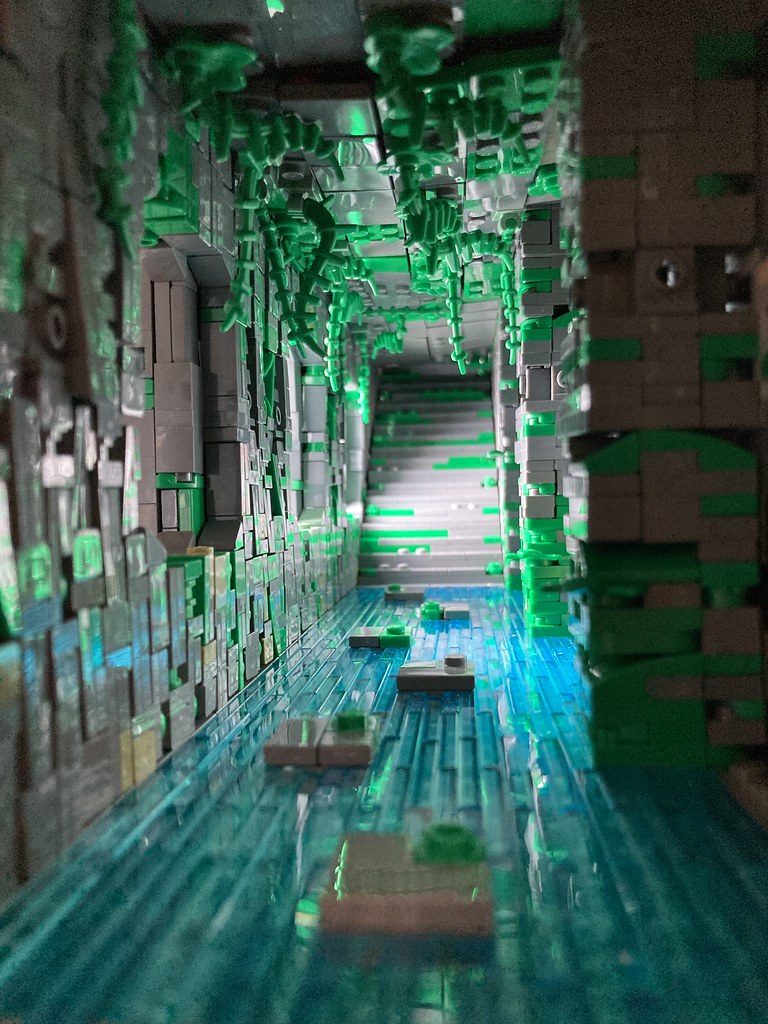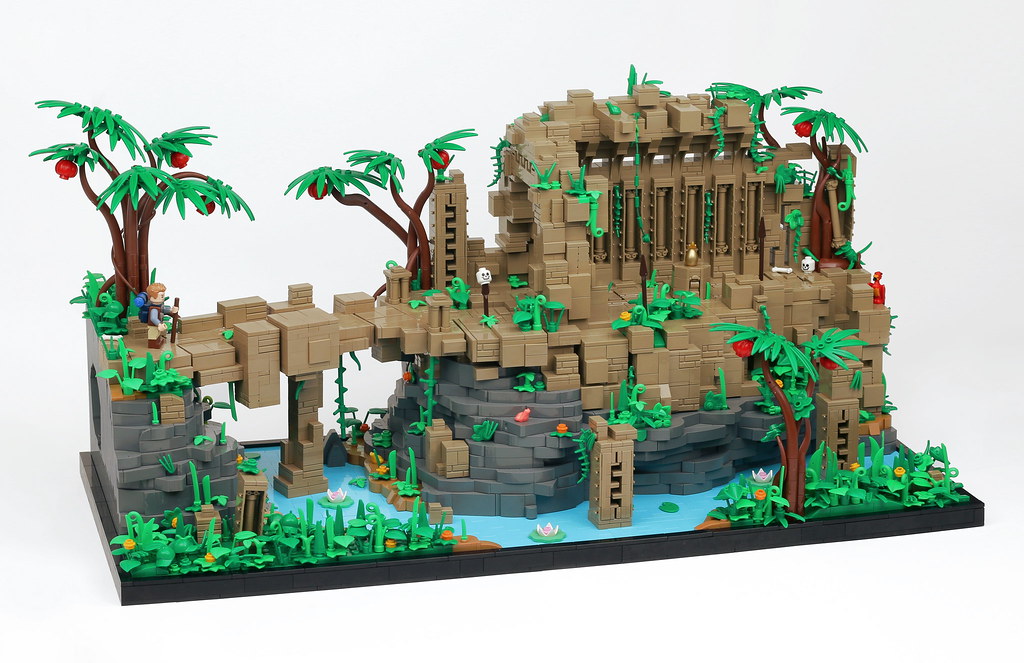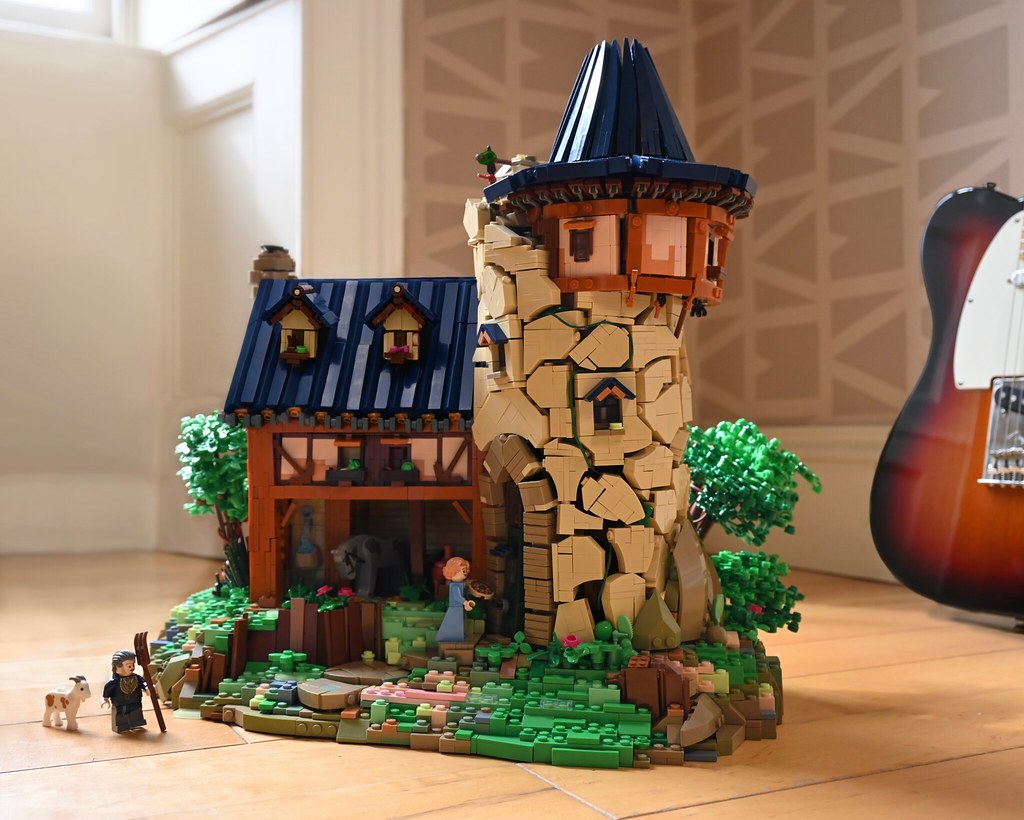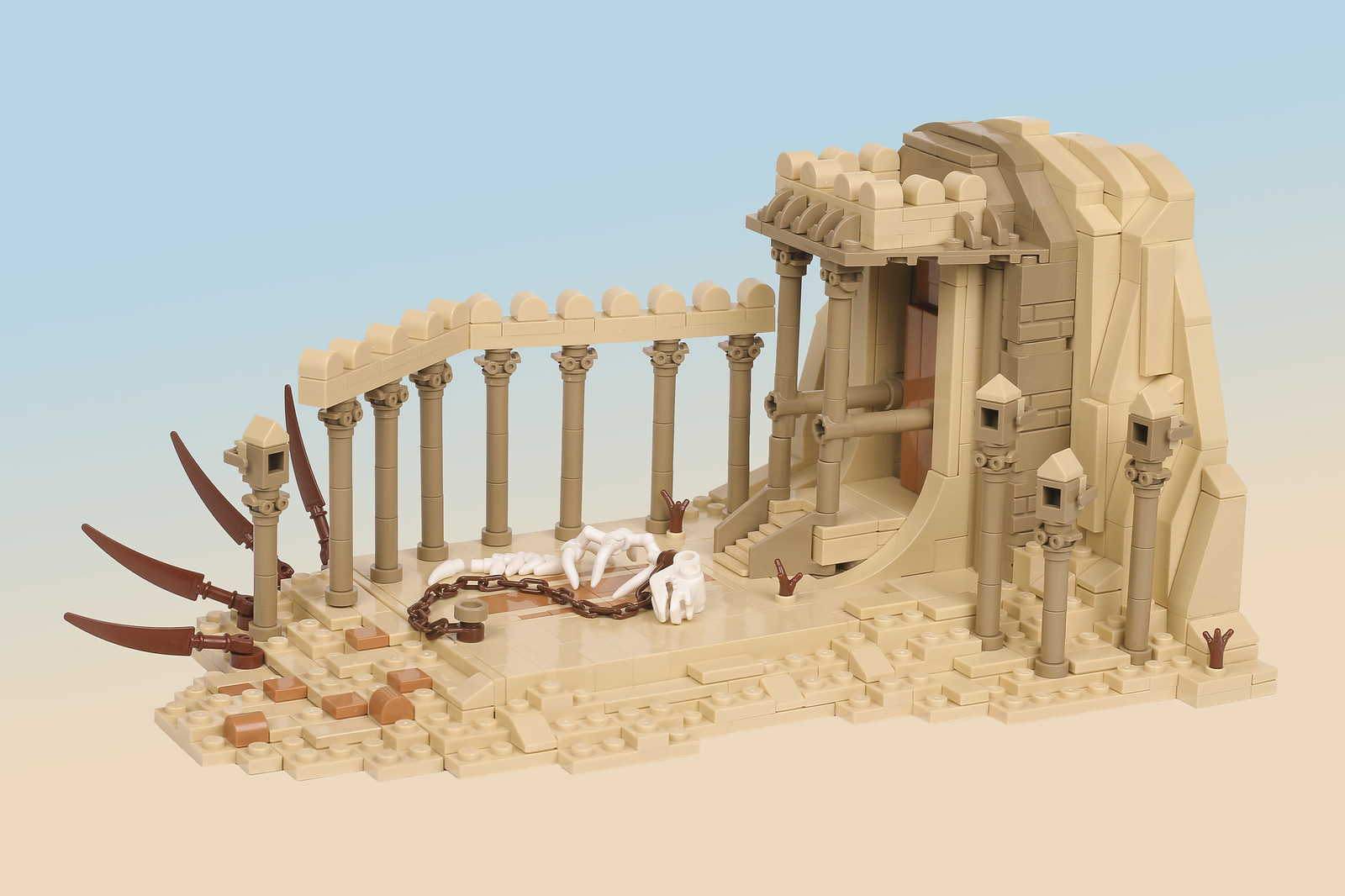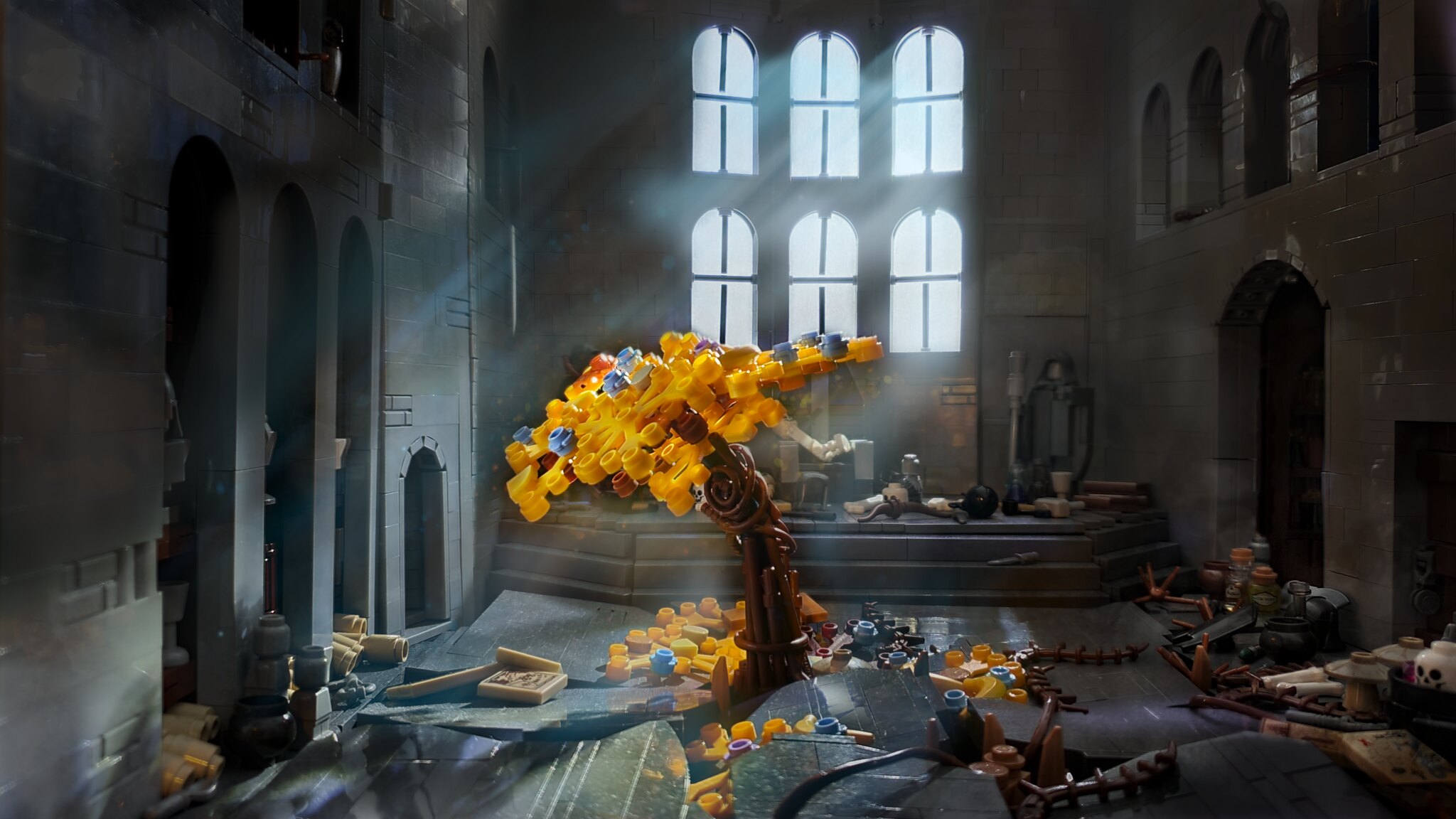Over the last year, generative AI images based on LEGO prompts have unleashed countless colorful images of jungles, ruins, and temples that lack the grace of a designer’s hand but sometimes hint at what could be built. It was images like those that prompted Syrdarian to build a jungle temple in real bricks, complete with the bright colors and flowing water that’s so appealing. I’m impressed by how well the mix of tan, peach, and orange shades blends together, and how two shades of azure blue works better than one. The scene suggests the play of light and shadow. The stonework is nicely accented by subtle details, like the wooden scaffolding and a lone duck peeking out from the corner. Syrdarian’s model makes a good case that while AI slop will never replace the work of a master builder, it can still inspire.
Tag Archives: Ruins
Something wicked stirs beneath the spires
In a building system founded on right angles, stringing together a bunch of LEGO macaroni tubes is anarchistically delightful. The snaking black tubes in the ruins of An-za-kàr Uru Dingir from Mattia Careddu, however, are downright sinister. I love how the layered ruins evoke organic anatomy, with fleshy tan bricks curved around a bony white core. What did this once-great city look like in its prime, I wonder? The model is a rare example of architecture from a builder best known for their weird and wonderful character builds, and an exciting direction from one of our favorite builders of 2024.
LEGO Bricklink Designer Program Series 3 – Lost City: Ruining a good thing? [Review]
With the start of October, LEGO is speeding up the cadence of releases from the BrickLink Designer Program. There’s five new fan-designed sets up for pre-order this month, and we’ll be digging into our advance copy of BrickLink Designer Program Series 3 – Lost City by fan designer Thomas Lajon, exploring all the mysteries within it’s 3,506 pieces. Pre-orders for BDP Series 3 will begin on October 8th at 8:00 AM PT, at which point Lost City will be available for $289.99 USD. Read on to discover if this city has been ruined for the better.
LEGO sent The Brothers Brick an early copy of this set for review. Providing TBB with products for review guarantees neither coverage nor positive reviews.
Read on for our full review below!
When all you have is a hammer...
If you need to nail down how much great building you can fit into a little vignette, look no further than this fantasy LEGO scene by Cora! Lets start with the real main character of this build: hammers. Cora has created an deeply authentic piece of brickwork out of enough hammers to make Thor drool! As for character design, Cora has kit-bashed a great minifigure out of parts from a bunch of different action lines. And with all that heavy equipment, I do wonder whether the crocodile has delved deep to find this treasure, or if it’s the reason it’s lying there in the first place?
Well, well, well, what do we have here?
For a lot of treasure hunters, the real treasure was the great LEGO builds we found along the way! This build by Eli Willsea portrays a pair of adventurers delving deep into a empty desert ruin, but what it really shows off is a trove of fantastic building techniques! Down on the floor of the lost well the cracked tiles are made from the immensely useful cheese slope, but did you notice they’re embedded in 1x2x3 windows? On the back wall, Eli uses those windows again with minifigure brackets as decoration. Finally, if you take a look at the well itself, you’ll see that it’s a combination of cheese slopes and 1×1 bricks with sideways studs which fit so well inside an 8×8 dish!
Less than 50 shades of grey
I love it when a LEGO build leans into an aesthetic. This build by Jessica Farrell is done completely in monochrome – like an old timey movie – and displays a crumbling landscape frozen in stone and fossilization. There’s more interesting parts in this build than I can point out, but here are some of the highlights! Sprinkled around the build you’ll see tiny flowers in flat silver. These flowers were only available from the Trolls World Tour 2020 product line, while the arching spine on the upper left is made of parts that ceased production in 2016. There’s vines climbing the ruined pillars, and gears big and small. One thing I know for certain, Charlie Chaplin has to be hiding in there somewhere!

A ruin in four LEGO colors
LEGO builder Pan Noda has a stellar record when it comes to color use. Not too long ago, I raved about this monotonal marvel that spilled forth from their mind. And while this creation goes a bit more subterranean than their previous work, it’s still a powerful bit of art composed of cobbled walls, hanging vines, and still water. Even though the palette here only uses four colors of brick (light gray, green, tan, and transparent light blue), their brilliant use of light transforms the scene into a symphony of shades. The uneven textures on the walls create pockets of shadow and reflective surfaces that bring the whole thing to life! Plus, it’s giving me the sudden urge to hunt for jungle temples in Minecraft….
LEGO Creation of the Week (#21): The Lost Temple by Jake Hansen and Eli Willsea
Every week readers of the The Brothers Brick Telegram channel choose the Creation of the Week: one project that impressed all of us the most. Neither a Pokemon, nor a fancy Fabuland starfither could crush a charming lost temple by Jake Hansen and Eli Willsea during our last week’s vote! Congratulations!
Meanwhile, the new vote is already on! Join our Telegram channel to follow all the best LEGO creations, latest news, and, of course, vote for your favorites. See you there!
A ruin of cubes amid the jungle
The dynamic duo of Jake Hansen and Eli Willsea have combined their LEGO talents to construct a glorious jungle scene based around a very boxy temple. The contrasts here are brilliant! The natural chaos of the jungle, replete with bladed vegetation, juxtaposes the right angles and clean lines of the temple. I love the choice of non-transparent blue for the water, adding to the feel of consistent color patches throughout the scene. But the real star here is the consistent architectural style throughout the temple’s ruin. Re-use of common patterns makes the build feel whole, while subtle variations on those modules gives the viewer an idea of the site’s state of decay. The consistency is so impressive that I was shocked it was made by two builders.
This tower is held together by the power of hopes and dreams
Most of the time I can figure out how a LEGO creation has been put together. Sometimes it is just a big riddle. This lovely build by Kit Nugent is one of those builds that I just can’t wrap my head around. What makes this creation really fun is the number of weird pieces hidden in it to add texture to the build. If you look closely, and I truly recommend that you do, you can spot all sorts of unique bricks. There is a pump bottle, a couple of hairbrushes and a rubber duckling hidden in the build to add texture to the landscaping. Last but definitely not least is the use of the Minecreaft pickaxe and the wand box blend in perfectly with the Tudor style of the home.
Bones and desert ruins forgotten by all but Time
Sun-bleached bones and an abandoned structure standout in the LEGO desert landscape by Eli Willsea. A feeling of loneliness and sorrow pervade the scene. Was this a sacred site with a sacred creature left alone due to unforeseen turmoil? Or was this creature the victim of sacrifice or punishment? None can say what happened here, only that the creature is long gone, its bones still bearing the weight of being tethered to the place. The structure around it towers overhead, an impressive mark on the landscape. Minifig roller-skates give detail to the capitals of the pillars. The banners on either side of the entrance stairs are seamless in their fitting, giving form to the staircase. High overhead, quarter tiles are wonderful vertical detailing for the entrance roof. The blending of soft and hard edges gives the scene a gentle, yet harsh, quality, not unlike the sand surrounding it.
Nature takes root in an abandoned castle
I really enjoy seeing examples of nature reclaiming abandoned spaces. Brick2 “Art”
has recreated this effortlessly in LEGO form with this scene of a tree taking root in an old castle.
There’s a lot of wonderful detail to be found in this build. The use of bars and whips in the construction of the tree adds a natural look to the trunk. Surrounding the tree, you’ll see other signs of nature looking to find purchase with some well placed mushrooms and tree roots.
Beyond this, we’re afforded suggestions of past castle life with a mix of scrolls, jars, and bottles discarded alongside weapons and the skeletons of the castle’s last inhabitants.
Let’s not forget the castle itself. Brick2 “Art” has composed this build with lots of subtle details suggesting the age of the citadel. And the arches along the sides offer the promise of more castle to explore. A final touch to this is how the light in this scene really adds to the composition, pooling the color centrally and making for quite the haunted scene!





